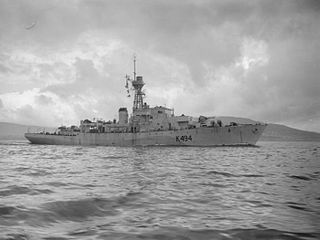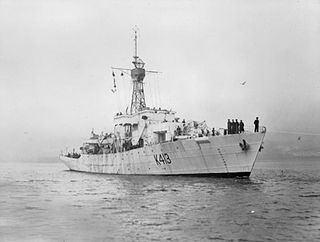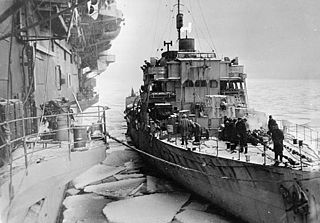
The Castle-class corvette was an ocean going convoy escort developed by the United Kingdom during the Second World War. It was the follow-on to the Flower-class corvette, and designed to be built in shipyards that were producing the Flowers. The Castle-class was a general improvement over the smaller Flowers which were designed for coastal rather than open ocean use.

HMS Flint Castle (K383) was one of 44 Castle-class corvettes built for the Royal Navy during World War II. Completed at the end of 1943, the ship ran aground while training in January 1944. After repairs were completed the following month, she was briefly assigned to the 39th Escort Group for convoy escort duties in the Atlantic Ocean. Flint Castle was transferred to Escort Group B2 in March and screened convoys to and from Gibraltar until September. That month, she joined Escort Group B3 to escort convoys between Canada and Britain and continued to do so until the end of the war in May 1945. The ship then became an anti-submarine training ship in Rosyth and Campbeltown, Scotland, before moving to Portland at the beginning of 1947. Flint Castle remained there until she was taken out of service in March 1956 and broken up beginning in July 1958.

HMS Berkeley Castle was a Castle-class corvette of the United Kingdom's Royal Navy. Built and commissioned in 1943, she escorted convoys from 1944 to 1945. She later served as an air-sea rescue ship until being placed in reserve. Damaged beyond repair in the North Sea flood of 1953 while at a dry dock in Sheerness, she was scrapped a few years later. She was named after Berkeley Castle in Gloucestershire.

The Algerine-class minesweeper was a large group of minesweepers built for the Royal Navy (RN) and the Royal Canadian Navy (RCN) during the Second World War. 110 ships of the class were launched between 1942 and 1944.

HMS Rising Castle was a Castle-class corvette built for the Royal Navy in World War II. She was named for Castle Rising in Norfolk, England. Before she was commissioned she was transferred to the Royal Canadian Navy and renamed Arnprior and given a new pennant number. After the war she was sold to Uruguay and renamed Montevideo.

HMS Farnham Castle (K413) was a Castle-class corvette of Britain's Royal Navy.

HMS Oakham Castle was a Royal Navy corvette of the Castle class. Built as a convoy escort during the Second World War, it later became a weather ship before being scrapped in 1977.

HMS Nunney Castle was a Castle-class corvette ordered by the British Royal Navy during the Second World War. The ship was transferred to the Royal Canadian Navy before completion and renamed HMCS Bowmanville. Bowmanville served with the Royal Canadian Navy in the final years of the war and was sold for mercantile use in 1946. Renamed Ta Shun, the ship sailed under a Chinese flag, later being renamed Yuan Pei. In 1949, the former corvette was taken over by the Communist-controlled government of China and rearmed and renamed Kuang Chou. Kuang Chou was listed until 1976 and was stricken in 1986.

HMS Hever Castle was a Castle-class corvette constructed for the British Royal Navy in the Second World War. Transferred to the Royal Canadian Navy before completion, the ship was renamed HMCS Copper Cliff and saw service as a convoy escort for the remainder of the war. Following the war, the vessel was sold for mercantile use and renamed Ta Lung, operating under a Chinese flag. In 1949, the ship was taken over by the Communist Chinese government, rearmed and renamed Wan Lee.

HMCS Hespeler was a Castle-class corvette of the Royal Canadian Navy which served during the Second World War as a convoy escort that was originally ordered as HMS Guildford Castle for the British Royal Navy but before completion was transferred and renamed. Following the war, the ship was sold for mercantile use, renamed Chilcotin in 1946, Capri in 1958, Stella Maris in 1960, and Westar in 1965. The ship was destroyed by fire in 1966 while at Sarroch, Sardinia. The hulk was taken to La Spezia, Italy where Westar was broken up.
HMS Norham Castle, initially named Totnes Castle, was a Castle-class corvette constructed for the British Royal Navy during the Second World War. Before completion, the ship was transferred to the Royal Canadian Navy, renamed HMCS Humberstone, and served the rest of the war as a convoy escort. Following the war, the corvette was sold for mercantile service, beginning as Taiwei in 1946 and ending as South Ocean in 1954. The ship was broken up in 1959.

HMS Woolvesey Castle, also spelled as Wolvesey Castle, was a Castle-class corvette constructed for the British Royal Navy during the Second World War. Before completion, the ship was transferred to the Royal Canadian Navy and was renamed HMCS Huntsville. Huntsville spent the rest of the war as a convoy escort. Following the war, the ship was converted for mercantile use and entered service as SS Wellington Kent in 1947. In 1951, the ship was renamed Belle Isle II. In 1960, Belle Isle II was sunk in a collision.
HMS Tamworth Castle was a Castle-class corvette that was ordered for the British Royal Navy during the Second World War. Before completion, the ship was transferred to the Royal Canadian Navy and renamed HMCS Kincardine, which used the corvette as a convoy escort for the rest of the war. Following the war, the ship was sold for mercantile use to French, then Moroccan interests and was renamed Saada in 1947.
HMS Walmer Castle was a Castle-class corvette constructed for the British Royal Navy during the Second World War. Before completion, the ship was transferred to the Royal Canadian Navy and renamed HMCS Leaside. The corvette was used as an ocean convoy escort during the war and was sold for mercantile use following it. The ship was purchased for use as a passenger ship and renamed Coquitlam, then in 1958,Glacier Queen. In 1970 Glacier Queen was acquired for use as a floating hotel in Alaska. The ship sank in 1978 and was raised and scuttled in Alaskan waters in 1979.

HMS Honeysuckle was a Flower-class corvette that served with the Royal Navy during the Second World War. She served as an ocean escort in the Battle of the Atlantic.

HMS Shrewsbury Castle was one of 44 Castle-class corvette built for the Royal Navy during the Second World War. She was named after Shrewsbury Castle in Shrewsbury. Completed in 1944, she was loaned to the Royal Norwegian Navy as a convoy escort during the war, renamed HNoMS Tunsberg Castle and was sunk by a mine in December 1944.

HMS Morpeth Castle was one of 44 Castle-class corvette built for the Royal Navy during the Second World War. She was named after Morpeth Castle in Morpeth. Completed in 1943, she was used as a convoy escort during the war and was scrapped in August 1960.
HMS Tintagel Castle was one of 44 Castle-class corvette built for the Royal Navy during the Second World War. She was named after Tintagel Castle in Tintagel. Completed in 1943, she was used as a convoy escort during the war and was scrapped in August 1960.
HMS Snapdragon was a Flower-class corvette that served in the Royal Navy and was built by Smith's Dock Company in 1940. She was named after Snapdragon. Commissioned in 1940 and sunk by Luftwaffe on 19 December 1942.

HMS Gardenia was a Flower-class corvette that served in the Royal Navy and was built by William Simons and Company in 1940. She was named after Gardenia. Commissioned in 1940, rammed and sunk by HMS Fluellen on 9 November 1942.















